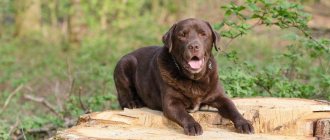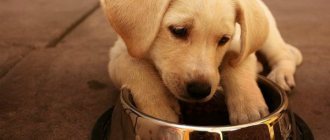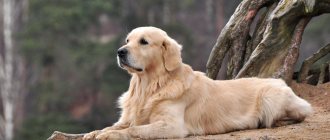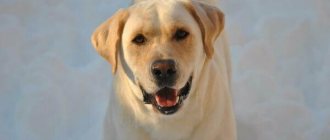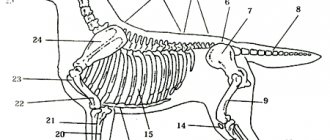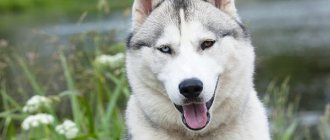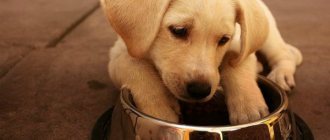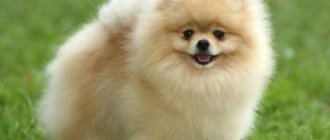Sooner or later, every owner thinks about the breeding time of a Labrador Retriever. It is very important to correctly determine this moment for both the bitch and the dog. Depending on gender, preparation for such an important event takes place differently. First of all, owners need to become familiar with the basics of dog breeding. Then choose a worthy pair for your pet and learn about the different mating methods. The most important thing is that you need to have a very clear idea of what awaits the owner after his Labrador becomes a mom or dad.
You will become a parent together with a dog
Women always play the main role in the reproduction of offspring in nature. They have to bear, give birth, feed and raise children. It is they who bear all the responsibility. Dogs are no exception. And Labrador Retriever bitches cope well with the responsibilities that nature has assigned to them. They are caring mothers and take excellent care of their babies.
However, their owner must also decide for himself: is he ready to become a parent with his Labrador girl? Whatever one may say, after six to eight more little puppies appear in the house, his life will definitely change.
Some Labrador owners consider it necessary for the bitch to give birth to puppies at least once in her life. This is supposedly necessary for health. We assure you that this opinion is wrong. Childbirth will not bring her any benefit.
Therefore, if you are the happy owner of a Labrador female, then think again about the need for mating. Remember that you will incur certain material costs, and the puppies that are born will need to be placed somewhere. And if you don’t have a queue of people waiting to buy a puppy for money, then you may end up at a loss.
Only for that person who consciously takes such a step, the cheerful squeaking of puppies in the house will bring extraordinary happiness. And our further story is intended specifically for these people.
How many puppies can be born?
Each time the number of puppies is individual. Usually their number is 5-6, but this also depends on heredity and how carefully the preparation for mating was carried out.
Often, during her first birth, a young bitch can even give birth to 1-2 puppies.
There are cases when dogs that are too old to give birth give birth to 11-12 dogs. In this case, you cannot do without a cesarean section, and in general such births are very dangerous for the health of the Labrador.
Setting a wedding date
The moment has come when your girl has grown up and can become a mother. Even at 7-10 months, you noticed her first bloody discharge from the genitals. The dog became irritable and easily excitable. This age is still considered adolescence, however, you should avoid communicating with male dogs and only go for a walk on a leash.
Also be prepared to stop often. Your pupil will sit down under almost every bush. You will now observe all these signs twice a year.
A Labrador female is considered ready for a “wedding” no earlier than her third heat, that is, she will be approximately one year and eight months old. Determining the right day for mating is not difficult if you carefully monitor your pet. The closer the beginning of the desired period, the more the bitch’s mammary glands swell. The external genital organ, the loop, also enlarges.
On the 11-14th day after the start of estrus, the color of the discharge from the loop changes. They become lighter. It is on these days that the dog should be taken on a date with the “groom”, since the greatest likelihood of conception occurs. And don’t forget to get rid of worms a month before the date, so as not to expose newborn puppies to the risk of infection.
Just in case, a so-called control mating is carried out every other day. The fact is that Labrador sperm live for three days. Meeting dogs again practically guarantees pregnancy.
First breeding of Labrador Retriever
According to the developed standards for the breed, the first mating of a Labrador should be carried out from 18-24 months for a female. And from 18 months for a male.
At 8-12 months the first estrus begins. During estrus, the bitch can already become pregnant. However, the young female is not yet ready to bear offspring. To get healthy puppies, do not rush to breed. The first mating of a Labrador should ideally be carried out 1.5-3 years after the first heat. In other words, after the third heat. Because early birth is harmful to the health of the mother and offspring.
Photo.. Mating a Labrador: first acquaintance.
The third one is not superfluous
Labradors have well-developed instincts. In the right period, the bitch behaves in an approachable manner. And the male, carried away by her scent, shows activity. Therefore, even young Labradors very often successfully mate on their own and naturally. However, when selecting a pair for a “girl,” it is better to choose an experienced male. And vice versa. The mating process will be easier if at least one of the partners knows exactly what needs to be done.
Since the male is the active participant in mating, it is better to organize the meeting on his territory. This could be a yard or a room. He himself should also be prepared. It is necessary to trim the nails if they are long. It is also advisable to file them smoothly. Then he will probably not hurt his partner. As for age, by the first mating he must be at least two years old.
If you doubt that Labradors will cope with the task on their own, then you can turn to the kennel club for help. The meeting can also take place there. The instructor will help the dog mount and hold the bitch in the desired position. This method is called manual.
Use some tips to prepare for mating:
- feed the dog 3-4 hours before the date;
- prepare a cup of drinking water in the area where the meeting will take place;
- have Vaseline on hand (it will come in handy if the bitch doesn’t have enough lubrication);
- just in case, take a muzzle with you (you should wear it if the dog shows aggression);
- do not forget to get the necessary vaccinations,
Some experts advise washing the bitch’s genitals with a solution of rivanol before mating. This is not necessary for Labrador Retrievers, but it will not cause harm.
In order to select a pair, it is best to contact dog handlers. The kennel club will do this professionally. All the characteristics of the partners will be taken into account: their weight, height, appearance, pedigree, health.
General concepts
Dogs have 78 chromosomes, or 39 pairs. In females, all chromosomes in pairs are homologous (similar to each other). Cables have only 38 homologous pairs, and the sex chromosomes are different. Chromosomes are carriers of genetic information. Genes that are located in the same place on paired chromosomes are called allelic. A trait received from one of the parents and appearing in the descendants is called dominant. The hidden trait of the other parent is called recessive. When none of the genes is completely dominant, incomplete or partial dominance occurs. If the genes of the producers are the same for a specific trait, they are called homozygous; if they are different, they are called heterozygous. The totality of all the genes of an individual is called the genotype, which is determined by the genes and their location on the chromosomes. The inheritance of qualitative traits is subject to the laws of genetics. 1. Law of uniformity of the 1st generation. All offspring of the 1st generation occupy an intermediate position or inherit the trait of one of the parents. 2. Law of splitting of the 2nd generation. In the case of crossing individuals of the 1st generation, a dominant trait of one of the parents appears, hereditary traits appear in a ratio of 1: 3. Dominant traits are obtained by 75% of individuals of the 2nd generation, and recessive traits - by 25%. When intermediate inheritance changes in the offspring of the 2nd generation, the original characteristics appear in the ratio 1: 2: 1 - 25% of the offspring receive the characteristics of one parent, 25% - the other parent, and 50% - both parents.
THE GENOTYPE OF A DOG CANNOT BE DETERMINED BY APPEARANCE 3. The law of independent splitting of characteristics. When crossing individuals with more than 2 different traits, each of them is inherited independently of the other. Determining the most successful crosses to produce successful offspring is a difficult task.
Basic rules for breeding dogs
To choose the right pairs for mating, you must be guided by the following principles: • dogs must be age appropriate; • the male and female must have a standard conformation; • the health of both dogs, both physical and mental, should not be in doubt; • producers must be in good shape; • overweight or underweight is unacceptable; • to make an optimal pair, the advantages and disadvantages of each dog are determined in advance; • compatibility of pedigrees is required; • only a male is suitable for improving the pedigree; • it is necessary to take into account the size of each dog, its weight, muscle development and skeletal structure; a large difference in these parameters leads to dysplasia in the offspring; • the male must be at least 18 months old, and the female must be at least 20 months old. Bitches can be bred through heat. Offspring obtained from a non-breeding bitch are not involved in breeding work, even if the puppies meet the Labrador Retriever standard.
Basic breeding methods
The main methods of selection are purebred and interbreeding. Currently, purebred crossing is used for breeding Labrador retrievers. Purebred crossing is divided into outbreeding, inbreeding, outcrossing and line crossing. The outbreeding process is close to natural; purebred Labrador retrievers that do not have common ancestors are selected for crossing. However, the offspring of such couples have unpredictable heredity. It does not guarantee clear signs in further generations. Experienced dog breeders do not use outbreeding, since this method increases the degree of heterozygosity of the genotype. For outbreeding, dogs are selected from 2 lines with the same qualities. The first generation of offspring has a large reserve of strength. The process of crossing related individuals is called inbreeding. This method is used only by professionals who know the gene pool of their producers. When selecting producers, their pedigrees are considered and common ancestors are designated using Roman numerals. If repeating rows of ancestors occur only on the side of one of the producers, these numbers are separated by commas, and if on both sides, by a dash. There are several degrees of inbreeding. Close inbreeding: I–II – son x mother; II–I – father x daughter; II–II – half brother x half sister; II–II – brother x sister; I–III – grandson x grandmother; III–I – grandfather x granddaughter; Close relationship: III–III; III–II, II–III, II–IV, IV–II, I–IV, IV–I; Moderate kinship: IV–IV, IV–III, III–IV, I–V, V–I, VI–I, I–IV. The process of crossing individuals that are distantly related through a common ancestor is called linebreeding. For this method, it is necessary that the ancestor-producer be at least the 3rd generation, with a good genotype, phenotype and stable transmission of important hereditary qualities. The method of crossing pairs without common ancestors for 4–5 generations is called outcrossing. Sires must be obtained through linear crossing. Their selection is made taking into account the disadvantages inherent in each line. Outcrossing is used to replenish the breeding stock with a dog or bitch that has the desired characteristic. This is an auxiliary breeding method. To remove bad genetic combinations from further reproduction, defective and weak puppies are culled. Only individuals with good gene combinations are retained to consolidate breed characteristics. Sometimes, when using the inbreeding method, the viability of the offspring decreases. This phenomenon is called inbreeding depression. In breeding work with a breed, the most optimal is a combination of inbreeding and linebreeding. With linear crossing of producers, the viability of the offspring increases. Then one can observe the opposite phenomenon of inbreeding depression - heterosis. Harmful mutations are in a recessive state; homozygosity of both lines is maintained for the necessary characteristics.
The main test for admission to kerung (breeding)
At the age of 2 years, the Labrador Retriever must undergo a test for admission to breeding, as he is already ready for social adaptation. This check is necessary to exclude dogs with mutations and undesirable qualities from breeding work and to identify individuals whose qualities need to be consolidated in the breed. Conditions for participation in testing In order for a Labrador retriever to be admitted to the dog breeding, there are certain rules: • maximum age – 5 years; • minimum age – 2 years; • presence of pedigree; • participation in 3 exhibitions (grades must be received from different judges and not lower than “excellent” or “very good”); • exams on training custom dogs must be passed (for females – level I, for males – level III); • availability of a document confirming passing the endurance exam; • the presence of x-rays proving the absence of dysplasia of the elbow and hip joints; • availability of a document confirming testing for hemophilia; • documents for identifying a male dog; • written confirmation by the owner that he is not aware of the presence of hidden breeding defects in the Labrador Retriever. Special conditions of the test Labrador retrievers who did not pass the test the first time can participate in testing again after a year. The test results are valid for 3 years. The results of the second kerung will automatically cancel the results of the first. Labrador retrievers are put up for a new breeding before the expiration of the old one, if the males had 3 litters, and the females had 1 litter without defects and deviations associated with heredity.
IF A DOG'S 2ND KERUNG IS SUCCESSFUL, THIS SERVES AS A BASIS FOR RECEIVING A LIFETIME KERUNG. The descendants of sires who have a Kerung receive a Kertsucht. After the Labrador Retriever reaches an age unsuitable for breeding, the collar is removed automatically. The breeding commission may revoke a kerung if the dog's breeding defects were not reported before testing or serious hereditary defects were identified in the offspring. Protests in such cases will not be accepted. Claims for damages are rejected.
Features of keeping a stud dog
A stud dog needs protein-rich food. His diet should include milk, eggs, raw meat, and fish.
THE MANUFACTURER CONSTANTLY NEEDS MINERAL FEEDING TO AVOID CALCIUM DEFICIENCY The amount of vitamins and microelements needed by a Labrador Retriever is calculated based on its weight, time of year and the loads experienced. To maintain physical fitness, the animal needs regular long walks and even exercise. It is recommended to maintain the hygiene of the stud dog. It is necessary to care for his genitals, and if various discharges are observed, douching with a solution of potassium permanganate or furatsilin is recommended. Douching is required after each mating. Also, to prevent a male dog from becoming infected from a breeding bitch, it is necessary to get vaccinated on time. To prevent the male from injuring the bitch during mating, it is recommended that he trim and file his nails. The first mating is recommended when the male turns 2 years old. It is undesirable to start mating earlier, since the animal has not reached physical maturity, and the offspring will not be viable. For a novice breeder, it is better to invite a specialist who understands all the intricacies and nuances of this process for mating. Theoretical knowledge cannot replace practical experience.
Features of keeping a breeding bitch
A dog reaches physical maturity by 2–2.5 years, and puberty occurs earlier. A female dog's first heat occurs at 7–10 months, but this does not mean that she is ready for fertilization. If the bitch is over 1 year old and has not yet been in heat, you need to contact a veterinarian. The first mating is recommended when the dog turns 20 months old (in the 3rd heat). It is necessary to carefully monitor previous heats in order to know all the features of this period. The normal frequency of estrus is once every 6–7 months. If the bitch's diet is poor in animal proteins, this may cause an increase in the pause between heats. During this period, the dog becomes restless, playful and irritable. During walks, your dog urinates more frequently. At this time, the bitch becomes uncontrollable, so she should be protected from male dogs and taken out for walks on a leash. 30–40 days before mating, the dog needs to be dewormed to prevent helminthic infestation during pregnancy.
Mating time
If you know exactly the start date of estrus, you can calculate the day of mating. During the period of estrus, the dog's mammary glands enlarge, and the external genital organ becomes larger and more noticeable. At this time, the bitch does not allow male dogs to approach her. Ovulation is most likely on days 11–14 of estrus. In some cases, the peak of ovulation may shift to the 5th or 23rd day of estrus. The day before ovulation is considered the optimal day for mating. By this time, bleeding will stop. The most reliable way to determine the date of ovulation is to analyze a vaginal smear. Subsequent matings are shifted by 2 days, because the first birth can cause a shift in the days of ovulation. The number of future offspring is determined by the number of ovulating eggs. It is recommended to carry out 2 matings with a daily interval. Labrador retriever sperm are viable for approximately 74 hours, so this method gives 4 days for fertilization and guarantees pregnancy.
Nothing terrible happens
When talking about mating, it is definitely worth explaining such a physiological phenomenon as a “lock”. Dogs enter this state in the final stage. Outwardly, everything looks quite strange. They stand with their backs pressed against each other. For ignorant people, it may seem that something terrible has happened - the poor animals cannot disentangle themselves and are stuck to each other. In fact, everything is understandable.
The fact is that during intercourse, the bulb of the genital organ (head) of a male dog increases significantly in size. At the same time, it is tightly clamped by the muscles of the bitch’s vagina. This is how a “lock” or state of gluing is obtained. The male can free himself only after the head reaches its normal size and the vaginal muscles relax. This takes 10-15 minutes, and sometimes more. This is how nature took care of creating conditions for fertilization during mating.
At this time, the dogs should not be disturbed; they should be given the opportunity to complete the process.
By the way, mating is also observed in other dog-like animals - wolves, hyenas, jackals.
Required documents
You need to have the following documents on hand:
- copies of passports of animal owners;
- copies of both pedigrees;
- originals of all exhibition documents (diplomas, certificates of assignment of titles) to dogs;
- a copy of the nursery registration certificate (if mating is not carried out by private individuals);
- a mating certificate signed by all parties (including the instructor).
The mating act must contain information about the pedigrees (with RKF numbers) of the future parents and the dates of matings (initial and control). The signatures of both owners are required, indicating that they identified the dogs, read the documents and carried out the mating.
The expectant mother is a vegetarian
You will learn about pregnancy no earlier than three to four weeks after mating. Main signs: an increase in the dog’s waist and swollen nipples. Sometimes, as a side effect, toxicosis occurs - the dog begins to vomit. Until this time, her lifestyle may not change at all.
Gestation for Labrador puppies lasts 62-64 days. In the second half of the term, discharge appears from the dog’s enlarged loop. Closer to childbirth, body temperature decreases slightly (the norm is 38-39 degrees). The expectant mother begins to look for a place for a “nest” and is capricious with food. Well, you can already see how the puppies move in her stomach if she lies on her side.
After the 40th day of pregnancy, the mother in labor should be given vitamins and more foods containing calcium.
However, two to three days before giving birth, fish and meat are excluded from the diet. They can increase blood pressure, trigger cramps, or cause swelling.
Now, during walks, the Labrador bitch herself begins to be cautious. You just have to help her. You only need to walk on a leash, avoid hard-to-reach places and difficult obstacles.
If the dog produces colostrum (the first milk, which has a thicker consistency) from the nipples, it means that birth is near. You have to wait a maximum of 2-3 days.
Care
Caring for a Labrador is not difficult. These are clean dogs and they know how to take care of themselves.
Bathing and grooming
Labradors simply love water treatments. However, you should not bathe your pet often. This can negatively affect the condition of his coat and skin. It is enough to do this once every 3-4 months or if the dog is very dirty.
You need to wash your pet with warm water. Use dog shampoo. Soaps and products formulated for humans are not suitable.
It is more convenient to do this together. But, if the dog reacts calmly to the procedure, then one person can handle it. First, the fur must be well moistened, and then the detergent must be distributed over the back and sides, then over the paws and tail. The hair is washed last. Be careful not to get water into your Labrador's eyes or ears.
If your dog gets dirty during a walk, you can bathe him in the shower without special products.
You need to brush the coat a couple of times a week with a massage brush or comb. During the molting period, this should be done every day. You can use a damp towel for this.
Eyes
Clean your eyes daily. Remove wet discharge with a lint-free cloth, and dry crusts that have formed with a cloth soaked in boiled water. Take your Labrador to the vet if the eyes develop pus or water during the day.
Teeth
Inspect your Labrador's mouth regularly. Especially during the period of teeth change. Sometimes a molar begins to grow when the baby tooth has not yet fallen out. A doctor's help is needed here.
You should like the new apartment
They are looking for a special place to support an extended family. Don’t wait until the last minute to resolve your housing issue. The woman in labor should have time to get used to and love her new “corner”.
It is best if it is some kind of separate room. If this is not possible, a fenced space of at least 1.5 x 2 m should be prepared for the mother and children, free from drafts and dampness. The height of the sides is approximately 20 cm. A dog can easily overcome such a barrier, but little ones cannot yet. As a result, they will not scatter across the territory.
While the puppies eat only mother's milk, the bitch will eat all their waste products. But when feeding begins, the character of the feces will change. And you'll encounter a lot of piles and puddles. So make sure in advance that it is easy for you to clean your little Labrador's living area. Old newspapers are suitable for this purpose as bedding. They have quite soft and highly absorbent paper. It will be easy to change them more often.
It happens that after mating, conception does not occur. However, after the allotted time, the bitch begins to behave like an expectant mother. She is worried, looking for a secluded place for a “nest”. There are also external signs - swelling of the nipples and even the release of milk from them. This condition is called false pregnancy. A possible reason is an inaccurate determination of the start date of estrus and the organization of mating on the wrong day.
To get rid of “pregnancy” and adjust your further actions, it is best to consult a veterinarian. He will recommend the necessary medications. But often all these signs go away on their own and without any medications, you just need to increase physical activity.
Outdoor content
Keeping a Labrador in a private home is a very good option for an energetic breed, but only if it is not a chain or an aviary. Keeping such a loving and human-dependent dog on the street is blasphemy.
The retriever feels lonely and his character changes dramatically for the worse. In conditions of social deprivation, the pet will become uninitiative and unsociable, perhaps even aggressive.
In addition to psychological abnormalities, a Labrador's coat, despite its thickness, is not able to protect it from severe frosts. In winter, the dog will constantly freeze and, as a result, get sick.
Tongue massage is required
The dog owner also needs to prepare for childbirth, especially if this happens for the first time. You should have sterile gauze wipes, a disinfectant solution, cotton wool, a heating pad for puppies, iodine or brilliant green, colored wool threads, and scissors with round ends on hand.
Labrador bitches usually give birth standing up. You will notice the onset of contractions by the contraction of your abdominal muscles. This stage lasts from 6 to 30 hours. Then a water bubble will come out of the loop and burst on its own. After him, the first puppy will be born. Your task is to catch it, but in no case pull or speed up the process, let everything go naturally.
The born baby must be freed from the shell, unless it bursts, or the dog itself does not do this. Using a strong thread, you need to tie the umbilical cord about two centimeters above the abdomen, then cut it off behind the knot. It is better not to allow the mother in labor to gnaw the umbilical cord, as she may inadvertently injure the puppy.
If a newborn has mucus in the nose and mouth, then you need to remove it with a swab or suck it out with a syringe. The mother must lick the puppy. With her tongue, she seems to be doing a massage, forcing all organs to work normally. Finally, place your puppy next to a heating pad covered with a towel to keep him warm.
Before the next baby comes out, you must have time to make notes in your notebook. Indicate the gender, weight, color and any distinctive features of the newborn. Write down the color of the thread you use to mark it around your neck. This is necessary in order to later distinguish the puppies from each other. For this purpose, you can use any other method convenient for you.
How to choose a pair?
When choosing a pair, especially if one of the dogs is mating for the first time, you need to be extremely responsible. It will be better if one of the Labradors - a female or a male - already knows what to do. Therefore, for the first mating of a female, select an experienced partner, and vice versa.
Of course, all dogs have highly developed instincts, and experience may not be useful. There are many cases where young Labradors did everything right the first time, but it’s better to be safe.
Prepare the chocolate
Adoption of subsequent Labrador puppies is similar to the first. They can appear at different intervals, which range from 1 to 10 minutes.
After the third or fourth puppy, you should walk the dog, give it a little exercise, for example, climb the stairs. A piece of chocolate will also help in further stimulating the uterus to contract.
It is imperative to count the afterbirth (placenta) that comes out behind each puppy. They are somewhat similar to raw beef liver. The first two or three of them will be beneficial for the dog to eat. There are many essential nutrients that stimulate labor and milk production. Large amounts of afterbirth eaten can cause black diarrhea. The delivery of the placenta should also be recorded in a notebook. It is important. If even one remains in the dog's womb, inflammation of the uterus may begin.
As a last resort, to remove the remaining placenta, you can give an injection of oxytocin; the veterinarian will help you calculate the dose based on the dog’s weight.
What types exist
There are several types of Labradors and similar dogs.
| Type of Labrador Retriever | Description |
| Labrador | The most common type of Labrador, which is preferred for families. |
| Golden (golden) | A separate species of golden retriever. Color is not a deviation. They have long hair. |
| Straight-haired | They have straight, long hair and can be black or brown. |
| Curly-haired | The coat of this Labrador has tight curls. The proudest of all Labradors. |
| Chesapeake Bay | Is of American origin. Bred for hunting game, named after the Chesapeake Bay, where it showed its best qualities. |
| Nova Scotian | A fiery Labrador with a white chest and belly, and a fox-like face. Also a hunting variety. |
The birth was successful, congratulations!
After labor is completed, observe the discharge from the loop. Gradually they should turn light pink. An unpleasant odor and greenish-brown color are an urgent signal to consult a doctor.
The birth can be considered completed if at least two hours have passed since the birth of the last puppy. Then you need to wash the bitch's genitals with warm water and take her for a short walk. Then place her next to the puppies and help them find their mother's nipples.
You have become acquainted with the general rules for mating Labrador Retrievers. And now you know how pregnancy and childbirth go in dogs of this breed. If you liked the article, like it and share it with your friends who will also be interested in this topic.
Tell us your opinion in the comments, tell us about your own experience, which may be useful for other readers.
Main features
The presence of an animal in heat can be determined when:
- there are brown spots and stains on the sleeping mat;
- for no apparent reason, the animal’s mood changes: the pet either falls into melancholy or becomes overly playful;
- short-term refusal to eat is possible.
It is impossible to accurately describe the behavior of an animal, since it depends on the individual processes occurring in the body.
When walking, the dog becomes extremely disobedient (which is uncharacteristic for it in everyday life) and tries to get away. The dog leaves marks every 4-7 meters. This is a kind of signal for males, a chemical signal to the opposite sex about full readiness for sexual activity and the birth of puppies (procreation).
NOTE!
Another obvious sign is shedding, which tends to appear during puberty in dogs.
Upon closer examination of the genital area, you can notice (if you look closely) a slight swelling and slight discharge of sexual secretion , which is dark brown in color and has a consistency similar to very liquid jelly.
First heat and its duration
The first heat in Labradors indicates the dog's sexual maturity. It usually begins after the change of teeth, with the dog’s normal development around 8–9 months. The Labrador Retriever is a fairly large dog, so the body takes a little longer to develop, and estrus can begin at one year of age.
The duration is individual for each animal, as it depends on the characteristics of the body and genetics. So it’s impossible to say exactly how long estrus lasts. The first heat may not last long, with little vaginal discharge. Subsequent ones last for several weeks. Your dog's behavior will help you recognize the onset of heat.
The bitch becomes active, often urinates and marks her territory, trying to spread her scent everywhere to attract males. Later the loop swells and a faint pink discharge appears. The dog may become restive and refuse to follow commands. Sometimes a Labrador will shed before going into heat.
Feeding
The Labrador Retriever is a tireless marathon runner and must be capable of long periods of work on land. And the need to swim in not always warm water requires the presence of a developed subcutaneous fat layer. Keeping warm also takes energy.
Therefore, by nature they are characterized by an excellent appetite. They eat as if they had enough left over for a week! Moreover, anything without being picky and sometimes deciding whether it can be eaten at all after the piece has fallen into the mouth.
A zucchini with legs is not a Labrador, but an unfortunate creature with shortness of breath and a bunch of chronic diseases. If you have a genetic tendency towards obesity, it is criminal to feed your dog!
The diet must be balanced: either natural food after consultation with a veterinarian, or good super-premium dry food. Plus active workouts to keep fit.
Since the breed's characteristics are omnivorous, hard vegetables and/or diced fruits work well as rewards. Reward is a small piece for flawless execution of a command, and not a kilo of carrots for beautiful eyes.
If the Labrador is on dry food, one of the feedings can be moved outside. First, the hungry dog has a good run, and then he works on the skills of obedience, endurance, and sampling. Without barriers, fetch and other fuss - a calm workout, so that there is not the slightest risk from the gastrointestinal tract. You can’t eat or run, because we’re not talking about a treat, but about a full portion.
Prohibit households from feeding the puppy from the table. Explain that he is not a trash can or a starving refugee from Africa. This is true for any breed, but Labras are perhaps one of the most gluttonous, along with Dachshunds. And it’s almost impossible to stop them from eating everything.
Brief characteristics of the breed
The Labrador is a smart, kind and friendly dog that will become a devoted friend and a true family member. Has the following appearance features:
- The height of adult representatives of the species at the withers is 56-58 cm.
- The weight of females ranges from 25-32 kg, and males 27-36 kg.
- The color of the coat is always solid, but can be different: brown, black, fawn.
- In the nursery, the cost of a puppy with all documents ranges from $500 to $800*. Without documents, a puppy will cost a little more.
- A healthy dog lives about 11-13 years.
Labrador dogs are sociable and intelligent
The difficulties of keeping pets include the constant need for physical activity. You can't leave them alone at home for a long time. Out of boredom and loneliness, they will begin to spoil the owner’s things, causing significant damage to the property.
Health
Problems with excess weight come first when describing the problems of the Labrador breed. Obesity leads to a variety of chronic diseases that shorten the life expectancy of an already not the healthiest breed.
Common genetic diseases
- elbow/hip dysplasia;
- osteochondrosis – improper formation of a joint, most often affecting the shoulders, elbows, knees;
- retinal detachment, cataracts and other eye diseases;
- hypothyroidism – lack of thyroid hormones;
- allergic reactions, mainly skin (dermatitis, eczema);
- Ichthyosis in Labradors, as a rule, occurs without damage to the immune system - profuse dandruff, crusts. Symptomatic support only, carriers do not get sick;
- nasal parakeratosis - crusts, painful cracks on the nose. Treatment is only symptomatic and ineffective.
